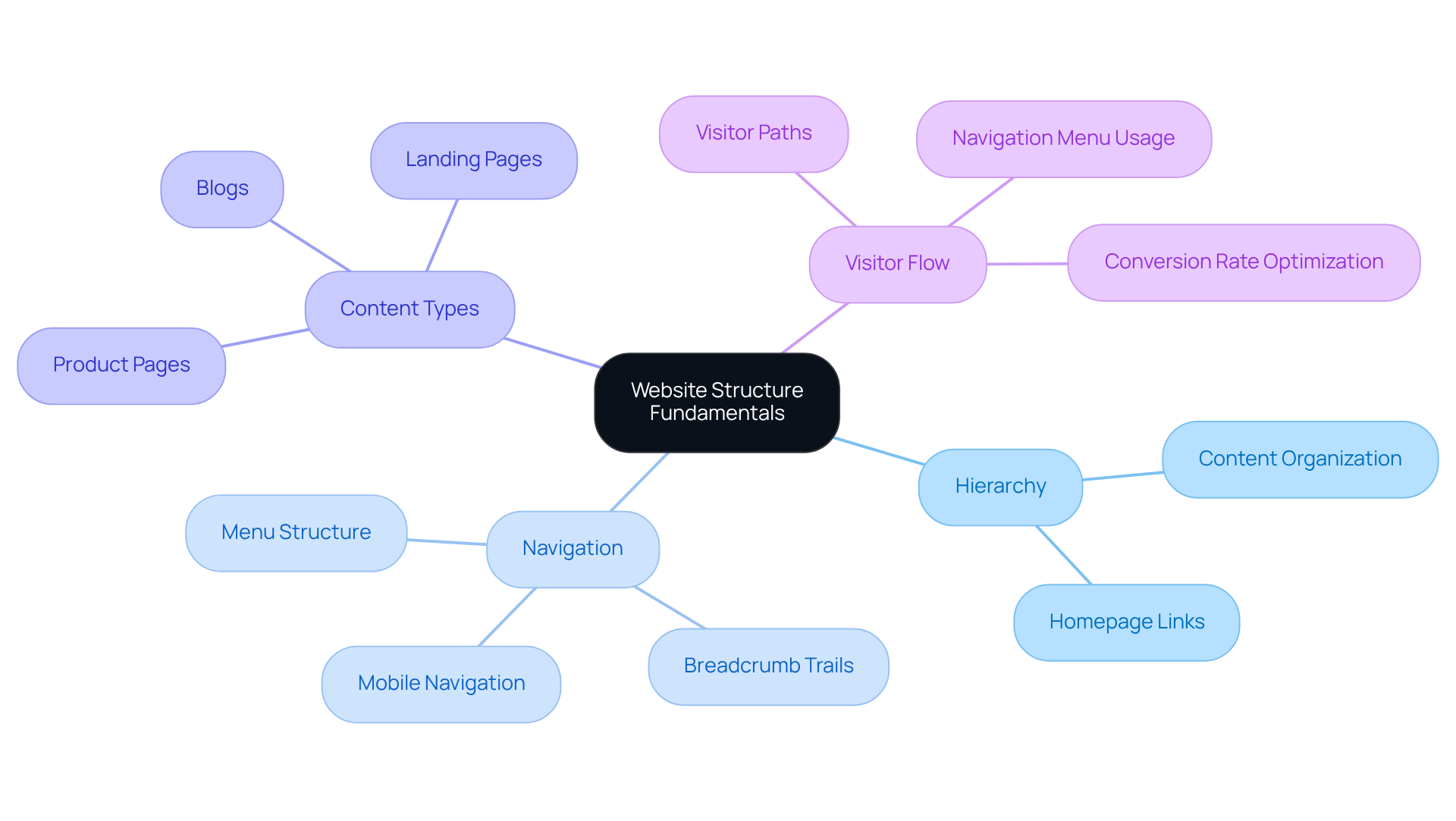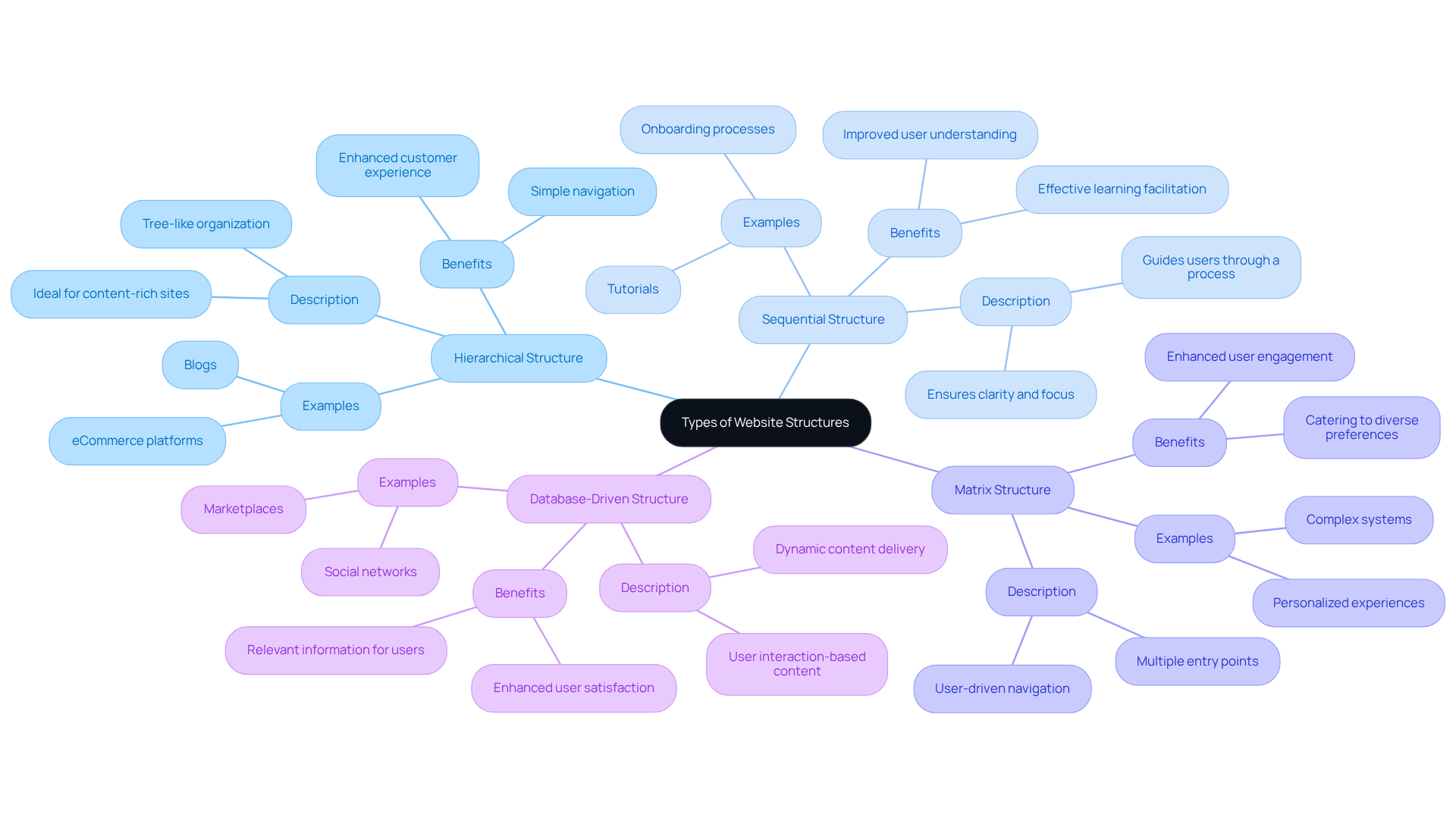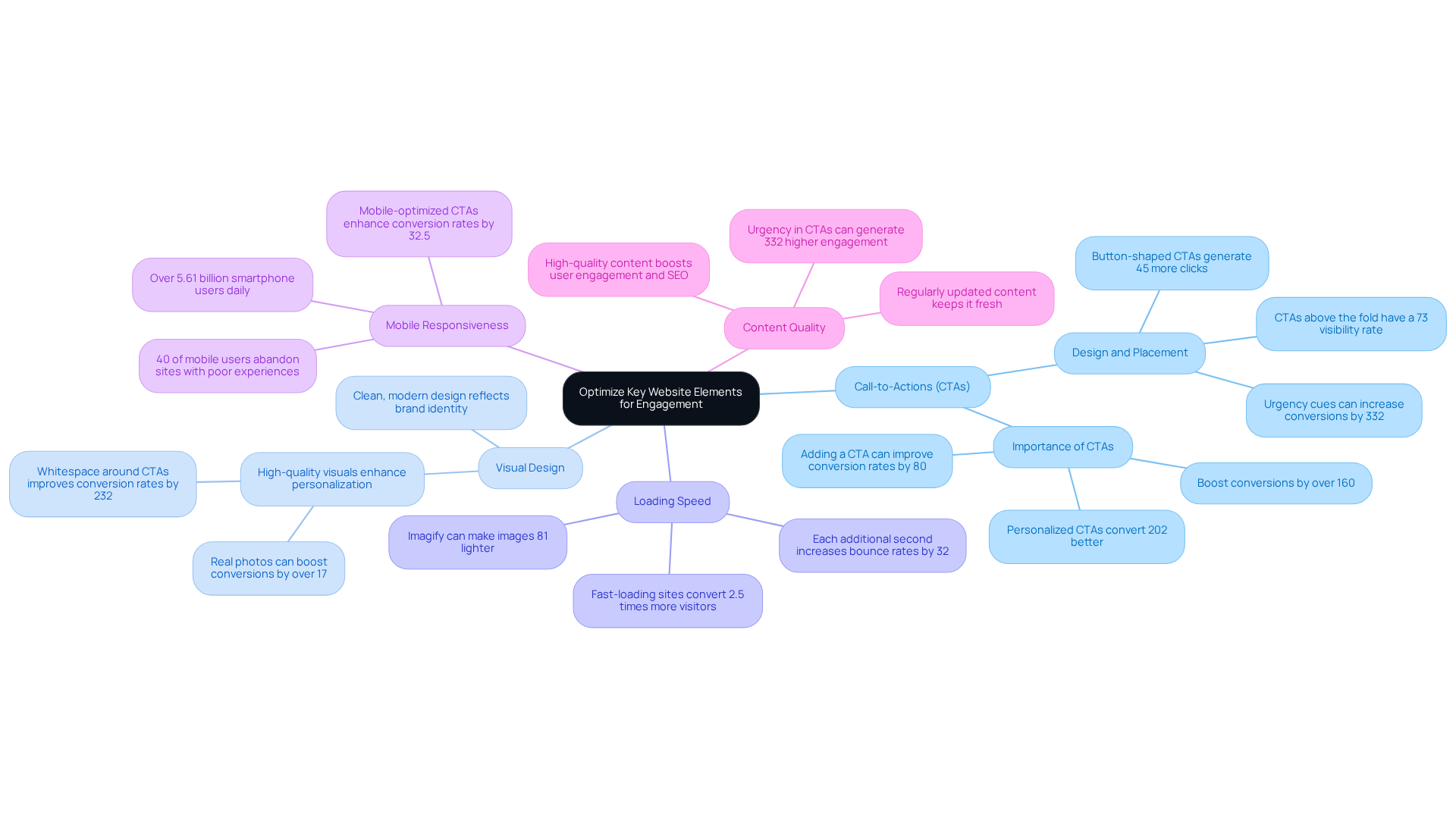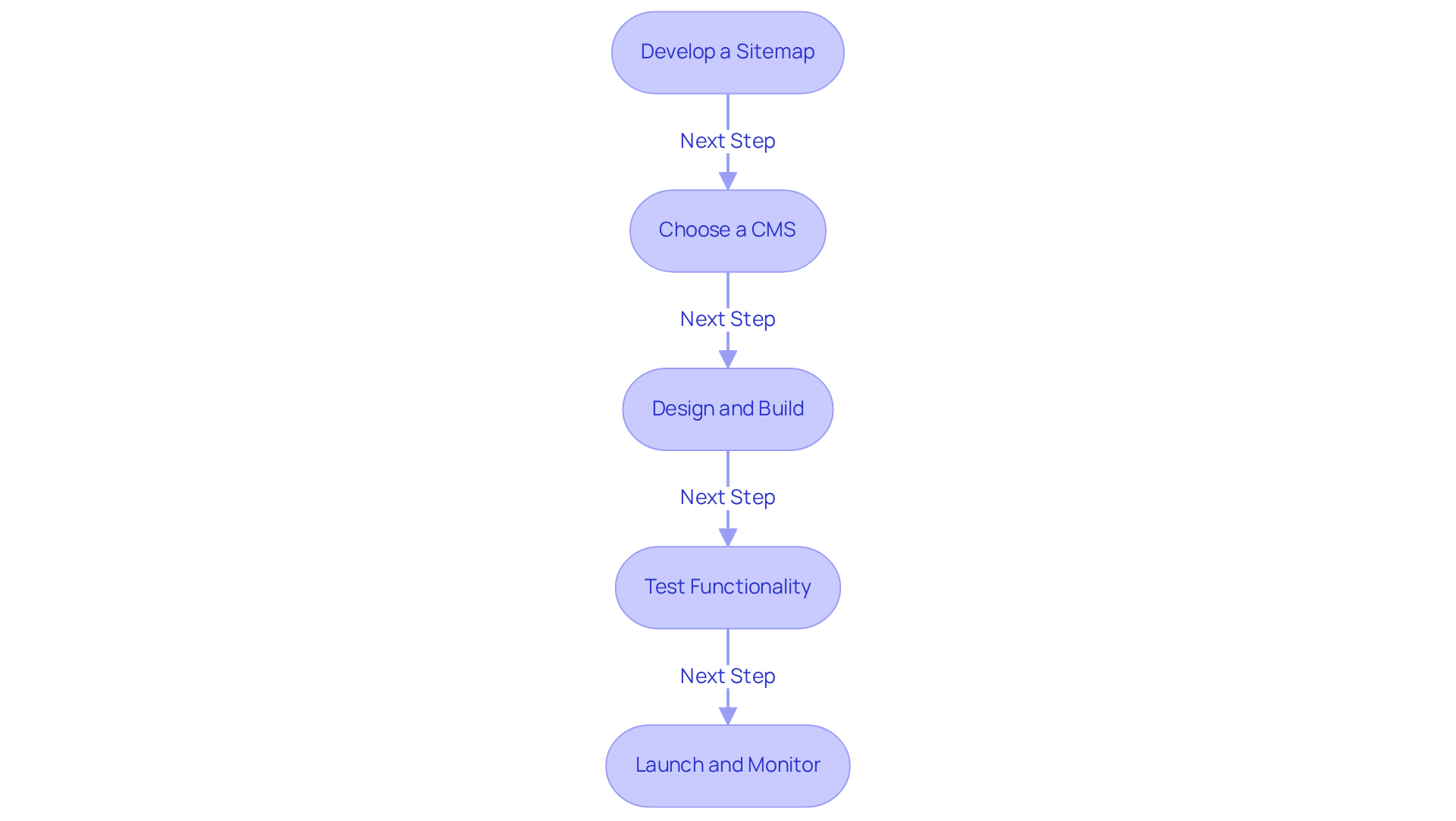Overview
Creating a structured website for tech startups can often feel overwhelming. Many founders grapple with understanding essential components such as hierarchy, navigation, content types, and visitor flow. These elements are not just technical details; they are crucial in enhancing user experience and engagement. When these fundamentals are overlooked, startups may struggle to connect with their audience, which can lead to frustration and missed opportunities.
However, by mastering these key aspects and selecting the right website structure, startups can significantly improve their conversion rates. This not only fosters meaningful connections with their audience but also supports broader business objectives. Imagine the relief of knowing that with the right approach, your website can become a powerful tool for growth and engagement.
We understand the challenges you face, and we are here to offer guidance. By focusing on these foundational elements, you can transform your website into a nurturing space that resonates with visitors. Remember, you are not alone in this journey; many have walked this path and found success by prioritizing their website's structure. Let's work together to create a website that truly reflects your startup's vision and values.
Introduction
Creating a successful tech startup can feel overwhelming, especially when it comes to establishing a compelling online presence. Many founders find that a well-structured website is not just a digital necessity; it is the very backbone of their identity in the digital world. It guides potential users through a seamless experience, fostering engagement and conversion. Yet, despite this understanding, many founders grapple with the complexities of website architecture. This often leads to confusion and missed opportunities, leaving them feeling frustrated and uncertain.
Have you ever found yourself questioning how to effectively navigate these challenges? How can you build a website that truly resonates with your audience and drives your business growth?
At RNO1, we understand these struggles and are here to help you find clarity and confidence in your digital journey.
Understand Website Structure Fundamentals
For many tech startup founders, creating a can feel overwhelming. It’s essential to grasp the fundamental components that form a . Without this understanding, the journey can become frustrating and lead to for connection with potential users.
One major aspect is Hierarchy. Organizing content in a way that reflects its importance is crucial. Imagine your homepage as a welcoming doorway, linking to major sections, which then guide visitors to sub-sections. A clear hierarchy not only aids navigation but also helps individuals quickly find the essential information they seek, making their experience more enjoyable.
Next, consider Navigation. It’s vital for users to easily find their way around your site. A clear menu structure and breadcrumb trails can make all the difference. Poor navigation can lead to abandonment, as . Remember, to be just as good, if not better, than the desktop version. This highlights how critical is, especially in today’s mobile-centric world.
Another key element is . Think about the different types of content your website will host—blogs, product pages, landing pages. Each type deserves its own layout and structure to ensure consistency and ease of access, making it easier for your audience to engage with your offerings.
Lastly, reflect on . How will individuals navigate through your site? Charting visitor journeys can illuminate the most logical paths for guests. With 50% of visitors relying on the navigation menu to find their way, optimizing this flow is essential. Websites with responsive design achieve 11% higher conversion rates, underscoring the importance of effective navigation in reaching your business goals.
By mastering these fundamentals, tech startups can build a strong online foundation through a structured website that not only enhances but also supports broader business objectives. As industry insights suggest, a well-optimized online platform can significantly boost conversion rates, making these structural elements vital for success. Forrester Research reminds us, "," emphasizing the value of investing in a well-organized online presence. Together, let’s navigate these challenges and create a website that truly resonates with your audience.

Choose the Right Type of Website Structure
Choosing the right layout can feel daunting, especially when trying to align with your startup's goals and the preferences of your audience. It's a common struggle that many founders face, and understanding the various structures available can ease this process. Here are some layouts to consider:
- Hierarchical Structure: This format works wonders for , such as or blogs. It organizes content in a tree-like structure, making navigation simple and intuitive. For instance, online retail platforms often utilize this framework to arrange items efficiently, enhancing and boosting sales. It's worth noting that research shows , underscoring the importance of having a structured website.
- Sequential Structure: This layout is particularly effective for websites that , like onboarding or tutorials. It gently leads individuals through the content, ensuring clarity and focus. Educational platforms frequently adopt this structure to facilitate learning, making it a valuable option.
- Matrix Structure: An adaptable method, the matrix structure allows users to choose their path through the platform. This is especially beneficial for complex systems with various entry points, catering to diverse preferences and enabling a personalized experience.
- Database-Driven Structure: Perfect for sites that require , such as social networks or marketplaces, this framework pulls content from a database based on . This ensures that individuals receive .
As you contemplate which framework to adopt for your structured website, remember to consider your startup's objectives and your audience's needs. A thoughtfully chosen structured website not only enhances usability but also fosters engagement, ultimately contributing to your startup's success. As IT expert Matt Loy wisely states, "." By incorporating expert insights and relevant statistics, you can further enhance your site's effectiveness and connect meaningfully with your audience.

Optimize Key Website Elements for Engagement
To enhance engagement on your website, it's important to address some common challenges tech startups face. Many founders struggle with converting visitors into loyal customers, which can feel overwhelming. But you’re not alone in this journey, and there are to help you navigate these hurdles.
- Call-to-Actions (CTAs) are crucial. By strategically placing clear and compelling CTAs throughout your site, you can gently guide users toward actions you desire, like signing up or making a purchase. Effective CTAs can , and simply adding one to your landing page can improve conversion rates by 80%. Personalizing CTAs can lead to an impressive 202% increase in conversions. Remember, as Anmol Ratan Sachdeva wisely points out, your CTA should never be an afterthought. Make sure they stand out visually; button-shaped CTAs can generate 45% more clicks than text links, making it easier for users to take that next step.
- Next, consider your Visual Design. A clean, modern design that reflects your brand identity is essential. , especially real photos, can enhance personalization and increase conversions by over 17%. Also, don’t underestimate the power of whitespace around CTAs; it can improve conversion rates by a staggering 232%, allowing users to focus on what truly matters. Incorporating social proof, such as testimonials, can further increase conversions by up to 161%, reassuring potential customers of your credibility.
- Loading Speed is another vital aspect. Optimizing images and scripts ensures your site loads quickly. A platform that loads swiftly can convert 2.5 times more visitors than a slow-loading page. Strive for loading times under 3 seconds; each additional second can increase bounce rates by 32%. Tools like Imagify can assist in compressing images, making them 81% lighter and enhancing overall site speed.
- Don’t overlook . With over 5.61 billion smartphone users daily, ensuring your website is is paramount. Mobile-optimized CTAs can enhance conversion rates by 32.5%. A poor mobile experience can lead to 40% of visitors abandoning your site, emphasizing the need for a mobile-first strategy.
- Finally, focus on Content Quality. Regularly updating your content keeps it fresh and relevant. High-quality, informative content can significantly boost and SEO. Incorporating urgency in your CTAs, like 'Limited Time Offer,' can enhance engagement, generating conversion rates that are 332% higher.
By concentrating on these elements, you can create a more engaging and user-friendly platform that invites visitors to explore further, fostering a sense of connection and community. Remember, you are not alone in this endeavor; these strategies can help you build a thriving online presence.

Implement Your Structured Website Plan
- Develop a Sitemap: Imagine the relief of having a . By outlining all pages and their relationships, you create a guiding map that will ease your development journey.
- Choose a CMS: Selecting the right can feel overwhelming, but it's crucial for your success. Consider popular options like WordPress, which powers 43.6% of sites globally and holds a 61.7% CMS market share. Shopify shines with its , boasting a 6.7% market share, while Wix offers user-friendly design tools. Each platform has unique features tailored to different business needs, so take your time to find the one that resonates with you.
- Design and Build: Collaborating with a web designer or developer can transform your vision into reality. Together, you can create an online platform that reflects your sitemap and design preferences. Remember, prioritizing ; after all, sites with achieve 11% higher conversion rates, making your efforts worthwhile.
- Test Functionality: Before you unveil your platform to the world, take a moment to thoroughly test its functionality, usability, and responsiveness. Check every link, form, and interactive element. It's important to recognize that retailers lose $2.6 billion each year due to sluggish online platforms, underscoring the need for optimal performance. With mobile devices accounting for nearly 66% of online traffic, ensuring your platform is is vital—over half of users will shy away from sites that lack adequate mobile design.
- Launch and Monitor: Once everything is ready, it’s time to . Utilize analytics tools to monitor user behavior and engagement, and don’t hesitate to make adjustments as needed to enhance performance.
By following these steps, you can navigate the complexities of creating a structured website, fostering a strong online presence that supports your growth objectives. Remember, you’re not alone in this journey, and with each step, you’re building a foundation for success.

Conclusion
Creating a structured website is a vital journey for tech startups looking to build a meaningful online presence. Many founders face the daunting challenge of understanding website architecture—hierarchy, navigation, content types, and visitor flow. Without this understanding, it can feel overwhelming. However, by grasping these fundamental elements, startups can craft an engaging platform that not only meets user expectations but also fosters business success. A well-structured website is not just a digital storefront; it is the foundation for attracting and retaining users, ultimately leading to higher conversion rates and customer loyalty.
In this article, we explored key strategies for optimizing website structures. From choosing the right layout—whether hierarchical, sequential, matrix, or database-driven—to focusing on essential elements like call-to-actions, visual design, loading speed, mobile responsiveness, and content quality, each aspect plays a crucial role in enhancing user engagement. By embracing these best practices, startups can create a user-friendly experience that resonates with their audience and supports their growth objectives.
The importance of a well-structured website cannot be overstated. It serves as a powerful tool for connection and conversion. We encourage startups to take these insights to heart and invest in a strategic approach to their online presence. By doing so, they will not only enhance user experiences but also pave the way for sustainable success in a competitive landscape. Remember, you are not alone on this journey; many have faced similar challenges and emerged stronger. Together, we can navigate the complexities of the digital world and achieve our goals.
Frequently Asked Questions
Why is understanding website structure important for tech startup founders?
Understanding website structure is essential for tech startup founders as it helps create a well-organized online presence, enhances user experience, and prevents missed opportunities for connecting with potential users.
What is the significance of hierarchy in website structure?
Hierarchy is crucial as it organizes content according to its importance, making navigation easier for visitors. A clear hierarchy allows users to quickly find essential information, improving their overall experience.
How can navigation impact user experience on a website?
Effective navigation is vital for helping users find their way around a site. Poor navigation can lead to visitor abandonment, with 61.5% of web designers identifying it as a primary reason for drop-off. Additionally, 85% of adults expect a mobile platform to be as good as or better than the desktop version.
What types of content should be considered when building a website?
When building a website, it’s important to consider various content types such as blogs, product pages, and landing pages. Each type should have its own layout and structure for consistency and ease of access.
What is visitor flow and why is it important?
Visitor flow refers to how individuals navigate through a website. Understanding and optimizing visitor journeys is essential as 50% of visitors rely on the navigation menu to find their way. A well-optimized flow can significantly enhance user engagement and conversion rates.
How does responsive design affect website performance?
Websites with responsive design achieve 11% higher conversion rates, highlighting the importance of effective navigation and user experience in meeting business goals.
What are the potential returns on investing in user experience (UX)?
Investing in user experience can yield significant returns, with Forrester Research stating that for every $1 spent on UX, businesses can expect a return of $100, emphasizing the value of a well-organized online presence.




